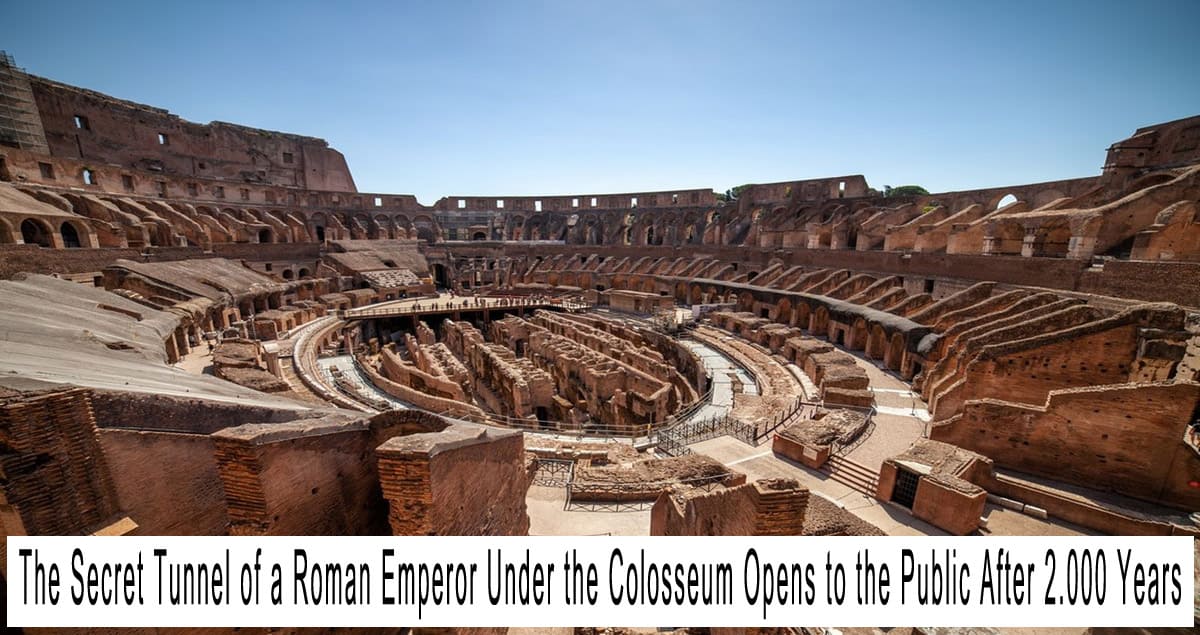The Secret Tunnel of a Roman Emperor Under the Colosseum Opens to the Public After 2.000 Years – After being hidden for almost two millennia, a secret tunnel once used by a Roman emperor has finally opened to the public. Known as the “Passage of Commodus,” this underground corridor connected the Colosseum with the imperial palaces on Palatine Hill. For the first time in 2.000 years, visitors will now have the chance to walk the same path once reserved for emperors — starting October 27, 2025. https://wearegntlmen.com
The Secret Tunnel of a Roman Emperor Under the Colosseum Opens to the Public After 2.000 Years :
A Hidden Passage with a Powerful Story
Stretching roughly 55 meters, the passage was first built during the reign of Emperor Domitian (AD 81–96) and later used by Emperor Commodus (AD 180–192). The corridor allowed the emperor to move between his palace and the arena unseen, ensuring both privacy and security.
According to the Roman historian Cassius Dio, Commodus often used this hidden path to make dramatic entrances into the Colosseum. He would sometimes appear dressed as a gladiator, much to the horror of the Roman elite. Nevertheless, this was no ordinary act of vanity. Rather, it reflected the emperor’s deep desire to merge spectacle with sovereignty. Thus, the tunnel symbolized not only secrecy but also the theatricality of imperial power.
From Damp Darkness to Restored Wonder
For centuries, the tunnel lay closed due to severe moisture and structural decay. However, during 2020–2021, the Parco Archeologico del Colosseo launched an ambitious restoration project. The team meticulously cleaned mineral deposits, strengthened ancient brickwork, and introduced a micro-ventilation system to stabilize humidity levels.
Moreover, modern glass walkways were installed so that visitors can safely explore the corridor while still viewing its original stone floor. Interactive panels and tactile maps now line the route, allowing guests to understand the tunnel’s engineering and historical context. In addition, digital projections recreate scenes of Commodus and his guards moving stealthily beneath the roaring crowds above.
As a result, what was once a dark, forgotten passage has become a living time capsule of Roman ingenuity.
Art, Symbolism, and Archaeological Finds
Inside the tunnel, intricate carvings of Dionysus and Ariadne adorn the marble walls. These mythological figures — representing wine, passion, and transformation — perfectly mirror the spirit of the Colosseum, where entertainment met extravagance.
In addition, several marble fragments depicting wild animals have been unearthed, likely referencing the spectacular hunts that once captivated Roman audiences. Such artwork, though decorative, carried strong political meaning. Indeed, archaeologists believe these images reinforced the emperor’s godlike status and connection to divine power.
Visiting the Tunnel: The “Full Experience”
The Passage of Commodus is not part of the standard Colosseum ticket. Instead, visitors must purchase the “Full Experience” pass, which includes:
- Access to the Colosseum’s underground hypogeum
- The Passage of Commodus
- The Roman Forum and Palatine Hill
The guided tour lasts about 90 minutes and welcomes small groups only. Consequently, each visitor can enjoy an intimate exploration of the site without the rush of large crowds. Guides also explain the advanced lift systems once used to bring gladiators and animals to the arena, as well as the architectural brilliance that made Roman engineering legendary.
For history lovers, this is not merely a sightseeing opportunity. Rather, it is a moment to connect directly with the heartbeat of ancient Rome.
Why This Reopening Matters
The revival of the emperor’s tunnel is more than a restoration effort. It marks a significant step in preserving and reinterpreting the Colosseum — one of humanity’s greatest architectural achievements.
Furthermore, the tunnel provides insight into the dual nature of Roman life. Above ground, citizens witnessed the grandeur of imperial games. Below ground, however, power moved silently through hidden corridors. Therefore, the Passage of Commodus bridges the gap between public spectacle and private authority.
From an archaeological perspective, this reopening demonstrates how ancient structures can be both preserved and experienced responsibly. It also reminds us that history is not static; it continues to evolve with every rediscovery and restoration.
Practical Information
- Location: Colosseum Archaeological Park, Rome, Italy
- Opening Date: October 27, 2025
- Ticket Type: Full Experience only
- Tour Duration: Approximately 90 minutes
- Languages: English, Italian, and others
- Tip: Visit early in the day to avoid crowds and enjoy optimal lighting in the underground area.
Final Thoughts
For those who view history as more than mere ruins, the reopening of the Passage of Commodus offers a unique and deeply personal experience. It allows visitors to walk where emperors once walked, to sense the cool air of ancient stone, and to imagine the echoes of a civilization that shaped the modern world.
The Colosseum has always represented the grandeur of Rome. Yet, this hidden tunnel — sealed for two thousand years — reveals the human side of empire: ambitious, mysterious, and endlessly fascinating.

